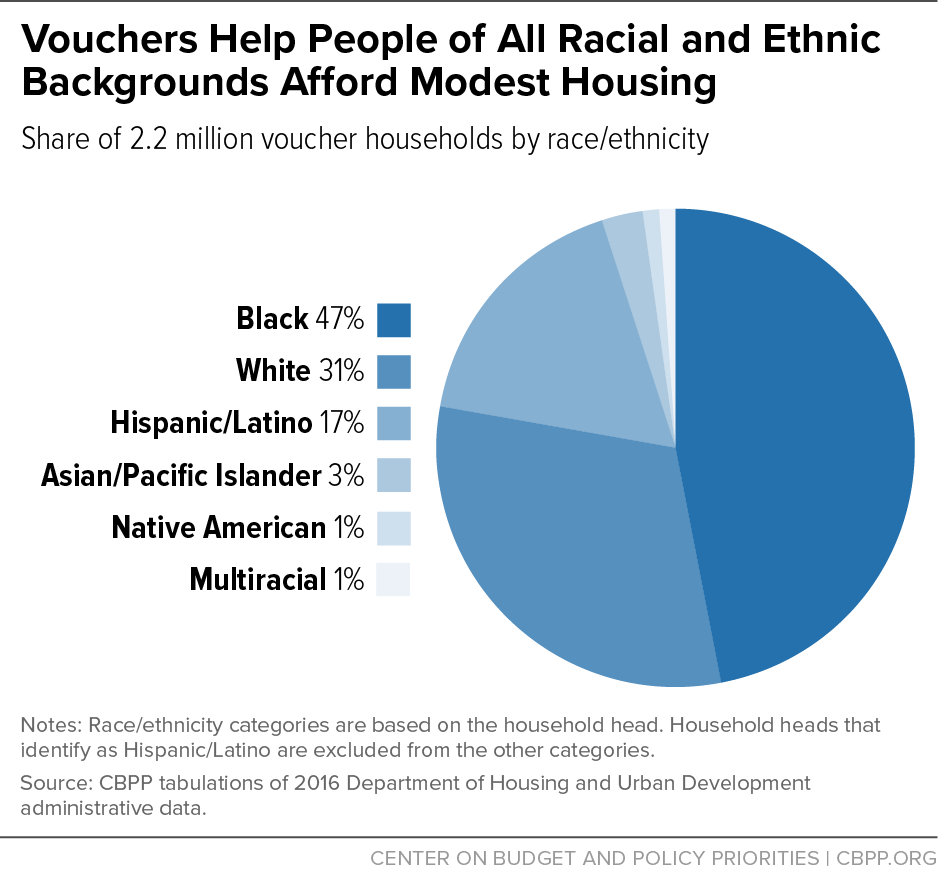BEYOND THE NUMBERS
This is the next post in our “Housing Vouchers Work” blog series, which provides the latest facts and figures about the Housing Choice Voucher program, the largest rental assistance program to help families with children, working people, seniors, and people with disabilities afford decent, stable housing.
After 40 years of policy evolution, evidence and experience show that Housing Choice Vouchers work effectively for all types of people and in all types of neighborhoods and housing. The federal policy framework also gives the state and local housing agencies that administer the program the flexibility to adapt it to meet local needs and priorities.
All types of households, including families with children, seniors, and people with disabilities, can use vouchers to obtain decent quality, modest housing they can afford. Vouchers help Americans of all racial and ethnic backgrounds to have a stable home (see figure).
Vouchers help house people effectively in a wide range of circumstances. They’re the most important tool for ending homelessness. Combining housing vouchers with health care and other services is a proven way to create homes in the community for people with histories of homelessness or institutionalization who also live with chronic, often disabling, health conditions. Along with protecting highly vulnerable individuals, vouchers enable low-wage workers to bridge the gap between their incomes and local housing costs.
Vouchers adapt to life changes. If a new child is born, or an older relative who needs care joins the household, the family may be eligible for assistance for a unit with another bedroom. And when children leave home and the household shrinks, the subsidy that the voucher provides will shrink as well. If household income increases, families’ share of the rent rises. But when workers lose their jobs, the voucher subsidy can rise so families can keep their homes. Or unemployed workers can use their vouchers to move to areas with more job opportunities, in the same state or elsewhere. No other type of rental assistance provides this flexibility.
Housing vouchers are available in every state and territory. They help low-income people pay the rent in small towns and rural areas, and in suburbs and large cities. Not surprisingly, families can more easily find a home to rent in markets with more available units, but effective program management can help overcome these challenges and ensure that eligible families use available vouchers.
Vouchers help a far larger share of families with children — and particularly more African American and Latino families — live in lower-poverty neighborhoods and avoid extreme poverty areas than other rental assistance programs.
Vouchers also enable families to choose the type of housing that best meets their needs. Many families use vouchers to rent single-family homes so their children can have a yard to play in, or to rent a lot for their mobile home in rural areas without much rental housing. Some agencies let families use vouchers to buy homes, and more than 20,000 households used vouchers to buy their homes through 2012, according to Housing and Urban Development Department data.
In communities where more rental homes are needed, agencies can make development more feasible and ensure properties serve people with a range of incomes by “project-basing” vouchers in a share of the units. These long-term commitments can help developers leverage funds for construction or rehabilitation and guarantee that affordable units will remain available to extremely low-income households even as neighborhoods change and rents rise.
To meet these diverse needs, policymakers should at least provide sufficient funding in the upcoming funding bill for 2017 to renew the more than 2.2 million vouchers in use.

